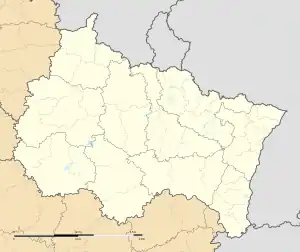Vitry-le-François
Vitry-le-François (French pronunciation: [vitʁi lə fʁɑ̃swa] ⓘ) is a commune in the Marne department in northeastern France. It is located on the river Marne and is the western terminus of the Marne–Rhine Canal. Vitry-le-François station has rail connections to Paris, Reims, Strasbourg, Metz, Dijon and several regional destinations.
Vitry-le-François | |
|---|---|
Subprefecture and commune | |
.JPG.webp) The town hall in Vitry-le-François | |
 Coat of arms | |
Location of Vitry-le-François | |
 Vitry-le-François  Vitry-le-François | |
| Coordinates: 48°43′32″N 4°35′07″E | |
| Country | France |
| Region | Grand Est |
| Department | Marne |
| Arrondissement | Vitry-le-François |
| Canton | Vitry-le-François-Champagne et Der |
| Intercommunality | Vitry, Champagne et Der |
| Government | |
| • Mayor (2020–2026) | Jean-Pierre Bouquet[1] |
| Area 1 | 6.45 km2 (2.49 sq mi) |
| Population | 11,458 |
| • Density | 1,800/km2 (4,600/sq mi) |
| Time zone | UTC+01:00 (CET) |
| • Summer (DST) | UTC+02:00 (CEST) |
| INSEE/Postal code | 51649 /51300 |
| 1 French Land Register data, which excludes lakes, ponds, glaciers > 1 km2 (0.386 sq mi or 247 acres) and river estuaries. | |
History
The present town is a relatively recent construction, having been built in 1545 at the behest of King Francis who wished to replace, on a new site, Vitry-en-Perthois, which in 1544 had been entirely destroyed as part of the backwash from the king's Italian War of 1542–46.[3] The new Vitry was to be a modern city, constructed according to a plan produced by Girolamo Marini. The king's role in its creation resulted in Vitry-le-François receiving the king's name as part of its own name.
At the beginning of World War I in August 1914, Joseph Joffre established the Grand Quartier Général at the Place Royer-Collard.
In 1961, a terrorist attack took place on a train going between Strasbourg and Paris.
Demography
|
| ||||||||||||||||||||||||||||||||||||||||||||||||||||||||||||||||||||||||||||||||||||||||||||||||||||||||||||||||||
| Source: EHESS[4] and INSEE[5] | |||||||||||||||||||||||||||||||||||||||||||||||||||||||||||||||||||||||||||||||||||||||||||||||||||||||||||||||||||
Features
- Its church of Notre-Dame is a 17th-century building with fine 18th-century monuments.
- A convent of the Récollets was later converted to contain the town hall, the court-house, a library and a small museum.
- There is a bronze statue of Pierre Paul Royer-Collard (1763–1845), the politician and philosopher, a native of the district.[6]
Personalities
- René Gateaux (1889–1914), mathematician
- Guy Georges (born 1962), serial killer
- René Herbin (1911–1953), classical pianist
- Abraham de Moivre (1667–1754), mathematician
- Étienne-Gabriel Morelly (1717–1778), proto-communist philosopher
- Simhah ben Samuel of Vitry (fl. c. 1100), Talmudist
See also
References
- "Répertoire national des élus: les maires". data.gouv.fr, Plateforme ouverte des données publiques françaises (in French). 2 December 2020.
- "Populations légales 2020". The National Institute of Statistics and Economic Studies. 29 December 2022.
- Chisholm 1911.
- Des villages de Cassini aux communes d'aujourd'hui: Commune data sheet Vitry-le-François, EHESS (in French).
- Population en historique depuis 1968, INSEE
- One or more of the preceding sentences incorporates text from a publication now in the public domain: Chisholm, Hugh, ed. (1911). "Vitry-le-François". Encyclopædia Britannica. Vol. 28 (11th ed.). Cambridge University Press. p. 151.